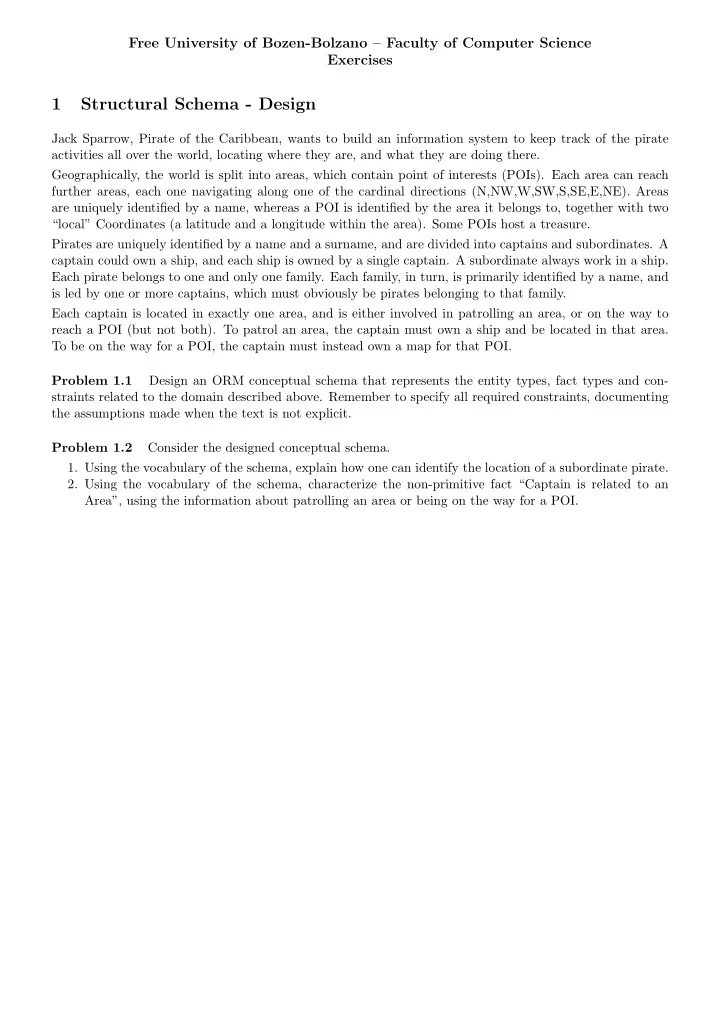

Free University of Bozen-Bolzano – Faculty of Computer Science Exercises 1 Structural Schema - Design Jack Sparrow, Pirate of the Caribbean, wants to build an information system to keep track of the pirate activities all over the world, locating where they are, and what they are doing there. Geographically, the world is split into areas, which contain point of interests (POIs). Each area can reach further areas, each one navigating along one of the cardinal directions (N,NW,W,SW,S,SE,E,NE). Areas are uniquely identified by a name, whereas a POI is identified by the area it belongs to, together with two “local” Coordinates (a latitude and a longitude within the area). Some POIs host a treasure. Pirates are uniquely identified by a name and a surname, and are divided into captains and subordinates. A captain could own a ship, and each ship is owned by a single captain. A subordinate always work in a ship. Each pirate belongs to one and only one family. Each family, in turn, is primarily identified by a name, and is led by one or more captains, which must obviously be pirates belonging to that family. Each captain is located in exactly one area, and is either involved in patrolling an area, or on the way to reach a POI (but not both). To patrol an area, the captain must own a ship and be located in that area. To be on the way for a POI, the captain must instead own a map for that POI. Design an ORM conceptual schema that represents the entity types, fact types and con- Problem 1.1 straints related to the domain described above. Remember to specify all required constraints, documenting the assumptions made when the text is not explicit. Consider the designed conceptual schema. Problem 1.2 1. Using the vocabulary of the schema, explain how one can identify the location of a subordinate pirate. 2. Using the vocabulary of the schema, characterize the non-primitive fact “Captain is related to an Area”, using the information about patrolling an area or being on the way for a POI.
2 Structural Schema - Analysis and Relational Mapping Consider the following ORM schema, modelling a fragment of the information system used for the setup of scientific experiments. Build a relational schema corresponding to the ORM schema, following the Rmap procedure Problem 2.1 and dealing with • the Scientist hierarchy following the partition strategy • the Task hierarchy following the absorption strategy; without introducing extra-information (i.e., by just using the fact types contained in the diagram). For each relation schema that you produce, highlight the primary key, alternative keys, mandatory and optional attributes. Depict relevant constraints, in particular all foreign key constraints. Problem 2.2 Consider the database schema obtained by applying the relational mapping as requested by the previous exercise. Is it possible to reconstruct the population of manual and automated tasks? If not, why? If so, how? Consider the extended diagram obtained by adding the following additional fact types and Problem 2.3 constraints: is supervised by Automated Researcher Task is reported back to • Show how relational mapping would handle this additional portion of the diagram. • Discuss how to transform this portion of the diagram so as to make the resulting database schema more compact. • Reapply relational mapping to the transformed diagram (just considering the transformed portion), and show the benefits of the transformation.
3 Process Modeling Consider the ORM schema about experiments depicted in the previous section. We now want to model a process that describes the creation of a task in an experiment phase. In particular, we want to model the private process executed by the system when interacting with the chief scientist responsible for that phase. The process starts when the chief scientist communicates his/her own identifier, plus the identifier of the experiments and the phase number. If the responsible for the phase is not the chief scientist who started the process, then the process immediately terminates with a security error. If instead the ownership is ok, the process goes on. In parallel, three information are requested, and then provided by the user: • device used by the task (request-answer); • type of the task (request-answer) followed by the name of the coordinator if it is a manual task (request- answer); • start+end time (request-answer). The process continues by sending a message to an external “scheduler” component that checks whether the device is available for the requested time span, then waiting for an answer. If the answer is negative, then the process terminates by sending a “device unavailable” message to the scientist. If the answer is positive, then the process registers the task, and terminates by sending an “ok” message to the scientist. Problem 3.1 Model the private process using BPMN. Consider the following BPMN process: Problem 3.2 B E + X X A D C F 1. Translate the process into a corresponding workflow net. 2. Draw the coverability graph starting from the standard input marking. 3. Exploit the coverability graph to explain whether the process is sound or not. 4. Discuss whether the reachability and the coverability graphs are different or not.
Recommend
More recommend